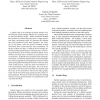129 search results - page 18 / 26 » A Graph Reduction Method for 2D Snake Problems |
DATAMINE
2010
13 years 7 months ago
2010
We address the combinatorial optimization problem of finding the most influential nodes on a large-scale social network for two widely-used fundamental stochastic diffusion models...
CSB
2005
IEEE
14 years 1 months ago
2005
IEEE
A genetic map is an ordering of genetic markers constructed from genetic linkage data for use in linkage studies and experimental design. While traditional methods have focused on...
CVPR
2012
IEEE
11 years 10 months ago
2012
IEEE
Depth ordering is instrumental for understanding the 3D geometry of an image. We as humans are surprisingly good ordering even with abstract 2D line drawings. In this paper we pro...
CVIU
2007
13 years 7 months ago
2007
The problem of face detection remains challenging because faces are non-rigid objects that have a high degree of variability with respect to head rotation, illumination, facial ex...
ISBRA
2009
Springer
14 years 2 months ago
2009
Springer
A tanglegram is a pair of trees on the same set of leaves with matching leaves in the two trees joined by an edge. Tanglegrams are widely used in biology – to compare evolutiona...

